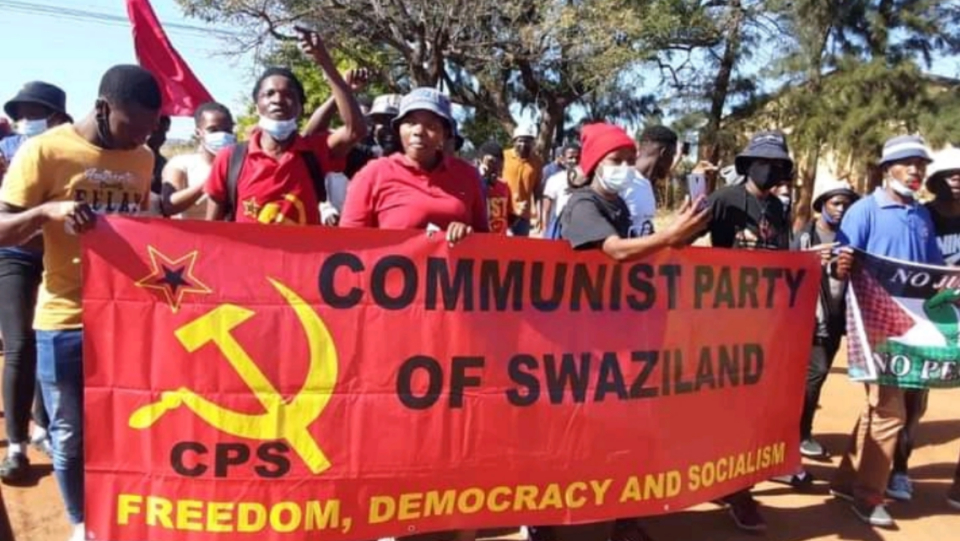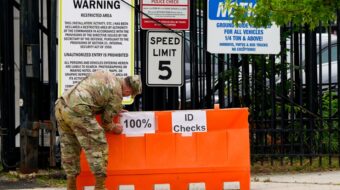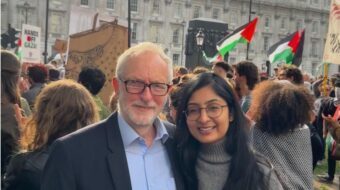
Life expectancy in Swaziland, in southern Africa, is the world’s seventh lowest; its HIV/AIDS prevalence is the world’s highest, at 26%. Unemployment is 41%, and wages for 80% of workers are less than $2 per day. Swaziland is an autocracy headed by a king, and it’s social and economic indicators show that the people are suffering under royal rule.
A Communist Party has existed in Swaziland since 2011, even though political parties are illegal there. Many activists, including Communists, are forced to live abroad, mainly in South Africa. What follows in this article is information about the Communist Party of Swaziland (CPS), its activities and goals, aspects of Swazi history, and current realities. The CPS urgently needs international solidarity.
Its recent story begins in early May 2021 with the mysterious death, presumably at police hands, of law student Thabani Nkomonye. The police violently disrupted his memorial services.
The National Union of Students mobilized masses of young people, and the police retaliated repeatedly with tear gas and bullets. Amid the uprising, the CPS called for legalization of political parties, overthrow of the “tinkhundla system” of control by chiefs in rural areas, and removal of the king.
During May and into June, the National Union of Students organized additional marches; 3,000 students advancing on a police station were met with tear gas and arrests. Anti-government protesters prevented 30,000 textile workers from entering their factories. The government responded by banning demonstrations.
The CPS called for a National Democracy Conference at which “a common minimum program could be achieved for transform[ing] the state from a monarchy into a republic.” Due to government repression an opposition division, no conference materialized. Writing a year later, analyst Joseph Mullen explains:
“In this moment…the anti-monarchy forces were themselves deeply divided. While the CPS represented the radical force pushing for the abolition of the monarchy and the prosecution of the King, some opposition forces expressed willingness to settle for a constitutional monarchy with an elected government…. They afforded too much power to bourgeois forces, who sought simply to reform the monarchy.”
Anti-government protests, continuing for weeks, climaxed on June 29, 2021. Swazi police and soldiers initiated violent repression. Within days, 70 people were dead and hundreds wounded.
Nationwide agitation returned almost a year later as opposition groups prepared for the one-year anniversary of the massacre. The CPS, playing a leading role, was targeted early. The police captured and tortured member Bongi Nkumbula on March 23. On July 13, they were again surrounding and approaching his house, but he escaped.
CPS cadres organized weekly “sunset rallies.” They urged communities to form “security councils” to protect against police incursions and organized “welfare councils” to deal with unmet housing, food, education, and healthcare needs.
In cooperation with the People’s United Democratic Movement (PUDEMO) and the Multi-Stakeholder Forum, “a platform of political parties, trade unions, civil society and other groups,” the CPS carried out vigils, set barricades, and called for schools and businesses to be closed on June 29, the anniversary day.
Police attacks continued. Security “forces shot live bullets at CPS members and activists” on June 26. Descending on sections of Mastapha municipality on June 28, they raided two houses CPS members were using as organizing centers.
The anniversary passed without killings, as was the case with an earlier period of turmoil connected to the party’s experience. In 2011, days of anti-government agitation by students, unions, and democracy organizations anticipated the fateful day of April 12. That was the day in 1973 when King Sobhuza II, father of the present king, banned political parties and repealed the constitution the British colonial power had granted in 1968. He ruled thereafter by decree. The CPS chose April 11, 2011, as the day for announcing its presence in Swaziland.
King Sobhuza II officially ruled from 1899 until he died in 1982, though he only assumed full powers in 1921, as he was only four months old at the time he assumed the throne. His reign is the longest of any monarch in human history. On becoming king in 1986, his son, Mswati III, reinstated parliament. His government devised a constitution that went into effect in 2006 and continues. It gives the king power to appoint the prime minister, cabinet, all judges, two thirds of the upper-house members, and 12% of lower-house members. The remaining legislators require approval from tribal chiefs, who are themselves appointed by the king. A harsh Suppression of Terrorism Act took effect in 2008.
A writer in 2011 summarizes: The Swazi monarchy “crushed the ambitions of all Swazis, [except for] a small parasitic elite based within the monarchy. The ambitions of the middle classes were curtailed by banning political parties and those of the working classes by suppressing the labor movement. The monarchy also enhanced its power grip…by controlling mineral royalties, business, and land administration.”
According to MRonline.org, “the royal family receives a 25% cut of all the mining deals…and as of 2016 has a budget of $69.8 million. The King, Mswati, has a net worth of $200 million and he controls a trust worth $10 billion.”
The Swaziland monarchy has enjoyed absolute power for centuries, even during the period of European colonial domination during the late 19th century. A British commissioner governed Swaziland from 1902 until Swazi independence in 1968. Even so, the monarchy exercised complete control over 33% of Swaziland known as the “native reserve.” On April 19, 2018, the 50th anniversary of Swazi independence, King Mswati III renamed Swaziland. Now, officially, it’s “the Kingdom of Eswatini.”
The People’s United Democratic Movement (PUDEMO), formed in 1983 and a member of the Socialist International, plays a major role in Swazi opposition politics. Others are: the Political Parties Assembly, the Ngwane National Liberatory Congress, the Economic Freedom Fighters of Swaziland, and the Swaziland Liberation Movement.
The United States, Taiwan, and a few other nations provide the monarchy with military supplies. Two Taiwan-supplied and U.S.- built helicopters were used for firing upon protesters in June 2021. The United States annually hosts 15 Swazi police officers at its International Law Enforcement Academy in Botswana and trains security personnel in the United States. The U.S.-based World Bank and Taiwan have provided Swaziland with generous loans. Swaziland is the only African country that recognizes Taiwan diplomatically.
South Africa’s government loaned 355 million euros to the cash-strapped monarchy in 2011 and maintains supportive relations. Swaziland looks to South Africa for 85% of its imports and 60% of its exports. The Congress of South African Trade Unions and the South African Communist Party have expressed support for democracy efforts in Swaziland.
CPS goals and strategies are evident in the statement the party issued on its first appearance in Swaziland in 2011. These sections are revealing:
“We join Swaziland’s mass democratic movement for change and pledge our full support to building that movement, led by PUDEMO, to bring about a National Democratic Revolution in Swaziland…. [But] We do not want see the monarchic autocracy reformed or dressed in democratic trappings to appease the liberal sensibilities of any interest group or the imperialist international community.”
The CPS calls for the “ending of the monarchic autocracy and the transfer of much of its wealth to the immediate tasks of fighting disease and the worst aspects of poverty (such as access to water and sanitation) [and] the confiscation of all crown property.”
Also: the “demand for democracy [as] a first step in an ongoing struggle to set our country on a totally different development path towards meeting all the needs of our people and creating a socialist system.”
In a statement appearing on Solidnet.org on July 6, 2021, the CPS urged Communist Parties of the world to pay attention to “news of what is happening in our country, to pressure the authorities in your respective countries to condemn the Mswati regime, … to lobby South Africa … to take more decisive positions against the lack of democracy and human rights in Swaziland.”
Our concluding emphasis is on Swaziland’s youth. They are many. Of 1.18 million Swazi people, 36.6% are less than 15 years of age. Young people have loomed large in opposing the regime, especially activist youth organizations like the National Union of Students and the Swaziland Youth Congress, PUDEMO’s youth group.
A report appearing on the CPS website highlights the plight of young people. Students had refused to take university exams. They claimed inability to study due to economic hardship. University authorities postponed the exams, but backtracked. Students protested, the police attacked, and the students sat for the exams on July 4. Afterwards, student Sphelele returned to his room and killed himself. The report notes that eight Swazi university students have recently committed suicide.
The CPS reporter cites the Condition of the Working Class in England (1845), written by “Comrade Frederick Engels.” He quotes:
“[O]nce a system has placed the working class under conditions in which they can neither retain health nor live long, and thus gradually undermine the vital force of the working class, little by little, and so hurry them to the grave before their time, such is nothing but social murder.”










